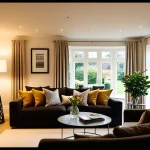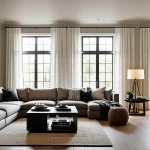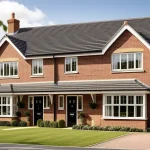Understanding the Emotional Impact of Interior Design
Interior design profoundly shapes our mood and home environment. The psychological effects of interior design stem from environmental psychology, which studies how physical spaces influence emotional well-being. When we ask, “How does interior design affect emotions?” the answer lies in specific design elements that trigger emotional responses. For instance, certain colors, lighting, and spatial layouts can induce calm, energy, or stress.
Experts agree that thoughtful design can improve mental health by reducing anxiety and encouraging relaxation. This is because well-designed environments foster feelings of safety, comfort, and control. Research reveals that cluttered or poorly lit spaces often increase stress, while organized, harmonious settings promote positive mental states.
Have you seen this : How Can You Maximize Comfort in Your UK Living Room?
Understanding the emotional responses to design also means recognizing individual differences. What creates serenity for one person might feel uninspiring to another. Therefore, tailoring interior design to personal preferences enhances the emotional benefits. Integrating this knowledge into home design allows for spaces that not only look pleasing but nurture well-being consistently.
The Role of Color in Influencing Mood
Colors have a profound impact on our mood and home environment by triggering distinct emotional effects through color psychology. For example, blue is commonly associated with calmness and serenity, making it ideal for bedrooms or relaxation areas. Red stimulates energy and passion, suitable for social spaces like living rooms. Yellow often evokes happiness and optimism, brightening kitchens or dining areas. The psychological effects of interior design are evident in how these hues directly influence our emotions.
In the same genre : How can UK investors leverage mortgage options for real estate acquisitions?
Experts recommend choosing home color schemes that align with desired moods—cool tones for tranquility or warm shades to energize. Studies confirm that balanced color palettes reduce stress and promote positive emotional responses to design. Incorporating accent walls or colorful decor can subtly enhance these benefits without overwhelming the space.
Understanding the power of color enables purposeful choices that elevate well-being. By harnessing color psychology, homeowners can create environments that positively affect emotions, improving their overall experience within the home. This thoughtful use of color makes interior design not just aesthetic but emotionally supportive.
Lighting: Enhancing Well-being and Atmosphere
Lighting profoundly influences the mood and home environment, making it a key aspect of the psychological effects of interior design. How does lighting affect emotions? Natural light promotes well-being by regulating circadian rhythms, boosting serotonin levels which improve mood and energy. Conversely, poor or harsh artificial lighting can increase stress and fatigue.
The impact of lighting on mood depends on intensity, color temperature, and placement. For relaxation, warm, dimmable lights create a cozy atmosphere, ideal for bedrooms and living rooms. Bright, cool lighting enhances focus and alertness, perfect for workspaces and kitchens.
Experts recommend layering light sources—ambient, task, and accent lighting—to balance functionality and ambiance. For example, combining natural daylight with adjustable artificial lighting helps tailor environments to various activities and emotional needs.
Simple home lighting tips include using sheer curtains to maximize daylight, installing dimmers for flexibility, and positioning lights to reduce glare. Thoughtful lighting design not only elevates aesthetics but supports emotional wellness by aligning illumination with daily rhythms and moods. This practical approach enhances the emotional responses to design in any space.
Layout and Space Planning for Comfort
Careful home layout and mood design directly shapes emotional responses to design. Open layouts often foster a sense of freedom and connection, encouraging social interaction and reducing feelings of confinement. In contrast, more segmented or closed layouts can create privacy and focus but may risk a cramped or isolated atmosphere if not balanced well.
The science behind space planning shows that flow—the ease of moving through spaces—affects comfort and well-being. A functional layout minimizes obstacles and clutter, allowing natural light and air circulation to enhance the mood and home environment.
Effective furniture placement supports positive emotional responses by promoting ease and intentionality. For example, arranging seating in conversational clusters encourages interaction and connection, contributing to feelings of warmth and safety.
Experts highlight that combining open and defined spaces thoughtfully can satisfy both social and private needs, improving the overall psychological effects of interior design. By understanding these principles, homeowners can craft spaces that feel inviting and emotionally supportive.
Furniture and Decor Choices for a Positive Mindset
The psychological effects of interior design extend significantly to furniture selection mood and decor choices. How do furniture and decor impact emotions? Carefully chosen furniture styles, such as soft, rounded edges versus sharp, angular pieces, can influence feelings of comfort or tension. For example, plush sofas encourage relaxation, while rigid seating might cause discomfort. Additionally, the arrangement of furniture affects emotional responses to design by facilitating openness or, conversely, confinement.
Decor psychology highlights the role of textures, patterns, and accessories in mood enhancement. Natural materials like wood or plants often evoke calm and positivity, contributing to a nurturing mood and home environment. Personalizing spaces with meaningful artwork or cherished items can trigger joy and a sense of safety.
Experts advise integrating elements that reflect personal tastes to boost emotional well-being. This personalization fosters connection and relaxation, making the home a sanctuary. Thoughtful furniture and decor choices are practical ways to shape uplifting spaces that align with individual emotional needs, ensuring design not only looks good but also feels good.
Practical Tips for Designing Mood-Boosting Spaces
Creating a positive mood and home environment can be achieved with practical interior design tips that combine color, lighting, layout, and decor. Experts suggest simple changes like introducing warm color accents or layered lighting design to uplift emotions. Using dimmable lights allows adjustment for relaxation or activity, while strategic furniture placement enhances flow and comfort.
To promote well-being at home, consider decluttering to reduce stress—an actionable strategy grounded in environmental psychology. Incorporate natural elements such as plants or wood textures to evoke calm and positivity. Personal touches, like meaningful artwork, can also deepen your emotional connection to the space.
Combining these elements amplifies the psychological effects of interior design by creating harmony between aesthetics and function. For example, a cozy corner with soft fabrics, warm lighting, and calming colors invites relaxation and joy.
By focusing on these mood-improving home ideas, homeowners can design spaces that consistently foster emotional wellness. Applying expert advice thoughtfully transforms everyday environments into uplifting retreats tailored to individual needs.










